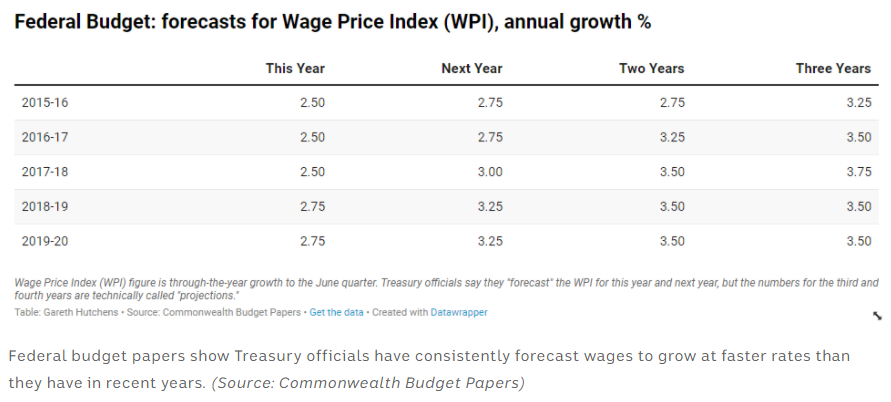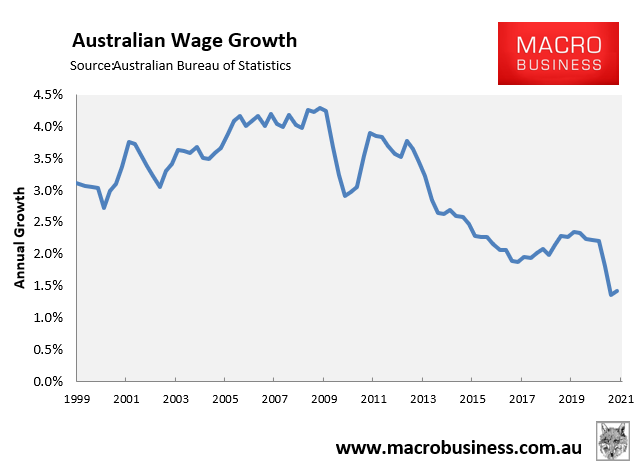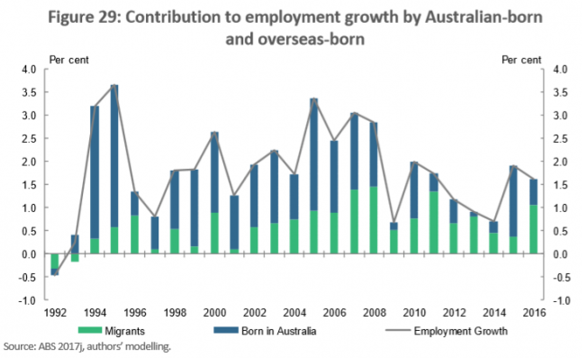Treasurer Josh Frydenberg has vowed to drive Australia’s unemployment rate to 4.5% after being advised by Treasury that this would help lift wages and drive inflation to its target of between 2% and 3%:
“We have a historic opportunity to drive the unemployment rate even lower back to where it was pre-pandemic and even lower still”.
This follows years of budget blunders whereby the Treasury consistently forecast that wage growth would rebound over the following three years:
Our contention has always been that a key driver behind Australia’s decade of falling wage growth is the federal government’s mass immigration policy. By adding 180,000 to 200,000 additional foreign workers to the labour supply every year, unemployment and underemployment were held higher than they otherwise would have been, resulting in lower wage growth.
Indeed, this was the very experience of Australia over the past decade, as illustrated clearly in the next chart:
Even the Australian Treasury’s Shaping a Nation report explicitly acknowledged that the overwhelming majority of Australia’s jobs growth went to migrants between 2011 and 2016, thus keeping unemployment elevated:
Recent migrants accounted for two-thirds (64.5 per cent) of the approximately 850,000 net jobs created in the past five years. For full-time employment, the impact is even more pronounced, with recent migrants accounting for 72.4 per cent of new jobs created.
Professor Peter McDonald released similar findings:
The permanent and temporary skilled migration policies established by the Australian Government from 1995 played an important role in meeting that labour demand…
From July 2011 to July 2016, employment in Australia increased by 738,800. Immigrants accounted for 613,400 of the total increase…
With this background in mind, how can Josh Frydenberg realistically hope to achieve his 4.5% employment target when he plans to reopen the immigration floodgates to pre-COVID levels from next year?
Treasurer Josh Frydenberg said he believed in restoring migration to the levels seen before the pandemic as soon as the government’s health experts declared it possible…
“The borders will reopen when it’s safe to do so, and when they do, net overseas migration will increase, including skilled workers”…
Mr Frydenberg said he wanted to restore migration to the level seen before the pandemic, which was 239,700 in 2018-19…
“I believe in a generous, sustainable immigration program that reflects the best of who we are, which is an open, tolerant, diverse country.”
If pre-COVID level of migration are restored, an extra 180,000 to 200,000 workers would join the Australian labour market every year, driving up unemployment and placing downward pressure on wages (other things equal). This, in turn, would make Frydengberg’s 4.5% unemployment target an impossible goal.
Australians experienced a decade-plus of crushed wages and living standards on the back of mass immigration. This failed policy must not be allowed to return. It’s time for Labor to take a stand.




